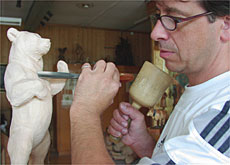Brienz offers tourists a hands-on treat

The woodcarving business in Brienz has been ringing rather hollow this year, with many Asians and Americans deciding to cancel their European travel plans.
But the town’s largest souvenir shop is trying to carve out a new niche in a bid to attract the few foreign tourists who have made the journey to Switzerland.
“Our new ‘hands-on event’ lets people experience what it’s like to make a traditional craft – whether it’s wood carving or assembling a music box,” explains Flavius Jobin, CEO of the Jobin art and crafts centre.
In the last few years, Jobin has turned the traditional woodcarving and souvenir shop into an interactive centre.
He has added a museum dedicated to the history of woodcarving, where visitors can trace the history of the trade in Brienz back to the early days of the 19th century and look over the shoulders of real woodcarvers at work.
And this year, people walking in off the street can choose, if they like, an incomplete carving, music box or ornamental wooden cow and they can add the finishing touches in an adjoining workshop themselves.
Cottage industry
Brienz craftsmen have been sculpting alpine fauna and nativity scenes since the beginning of the 19th century and selling them to tourists.
Many in the village have been living from the trade since then, and Brienz also boasts Switzerland’s only violin making school, which was set up about 60 years ago to take advantage of the villagers finely-honed woodcarving skills.
Wood from the abundant surrounding forests was one of the town’s few commodities, and woodcarving has over the years become a thriving cottage industry that sets Brienz apart from most other alpine villages.
Foreign retailers
In recent years, companies like Jobin have relied heavily on the American and Japanese markets.
Half of all of the company’s sales are made directly in Brienz and the other half through retailers mainly in the United States in Japan.
Either way, about 96 per cent of the souvenirs end up decorating mantelpieces abroad.
The company had a turnover of SFr8 million in 2000, and Jobin says he will be happy if the business generates just half that amount this year, because of the lack of Americans and Asians.
That is why he has hopes that his “hands-on event” will bear fruit and convince tourists to stay longer and spend more.
Master craftsman
On a good day, several buses pull up in front of the shop at the same time, evidence that Jobin has managed to convince several Asian and American tour operators to include the event in their itinerary.
One of the first groups to take part is given a tour of the museum before being led into a separate workshop, where they are given sets of screws and screwdrivers and the choice of music boxes.
The Japanese tourists listen intently to the instructions given by Jobin’s “master craftsman”, before being translated into Japanese.
All thumbs
They then set to work. Many members of the group prove to be all thumbs when it comes to inserting the mechanical pieces and the screws, but after half an hour and patient assistance by Jobin’s staff, all the boxes are assembled and set in motion.
An elderly Japanese woman smiles as she winds up her music box, humming along as it plays ‘Edelweiss’.
The Japanese tour guide says it is the only time during the ten-day trip that the members of the group have been asked to use their hands as well as their eyes to experience Switzerland.
“It’s quite special if you have the chance to take something home that you’ve made yourself,” Jobin says, hoping that his “hands-on event” will help see his shop through the hard times.
swissinfo, Dale Bechtel in Brienz
Brienz is Switzerland’s biggest and best known woodcarving centre.
Locals began making woodcarvings for tourists in the early 19th century.
The Jobin arts and craft centre was one of the first, founded in 1835.
Besides souvenir shops, Brienz has a woodcarving school and the country’s only school for violin making.
The town organises an international woodcarving symposium every few years.
Most of the wood for the souvenirs and other crafts comes from the surrounding forests – mainly spruce, ash, pine and maple.

In compliance with the JTI standards
More: SWI swissinfo.ch certified by the Journalism Trust Initiative

You can find an overview of ongoing debates with our journalists here. Please join us!
If you want to start a conversation about a topic raised in this article or want to report factual errors, email us at english@swissinfo.ch.